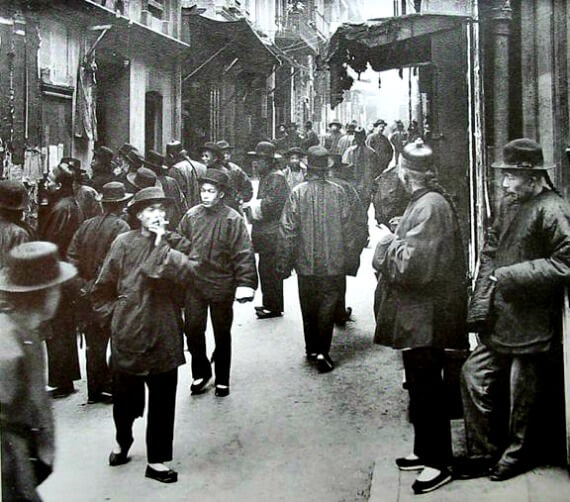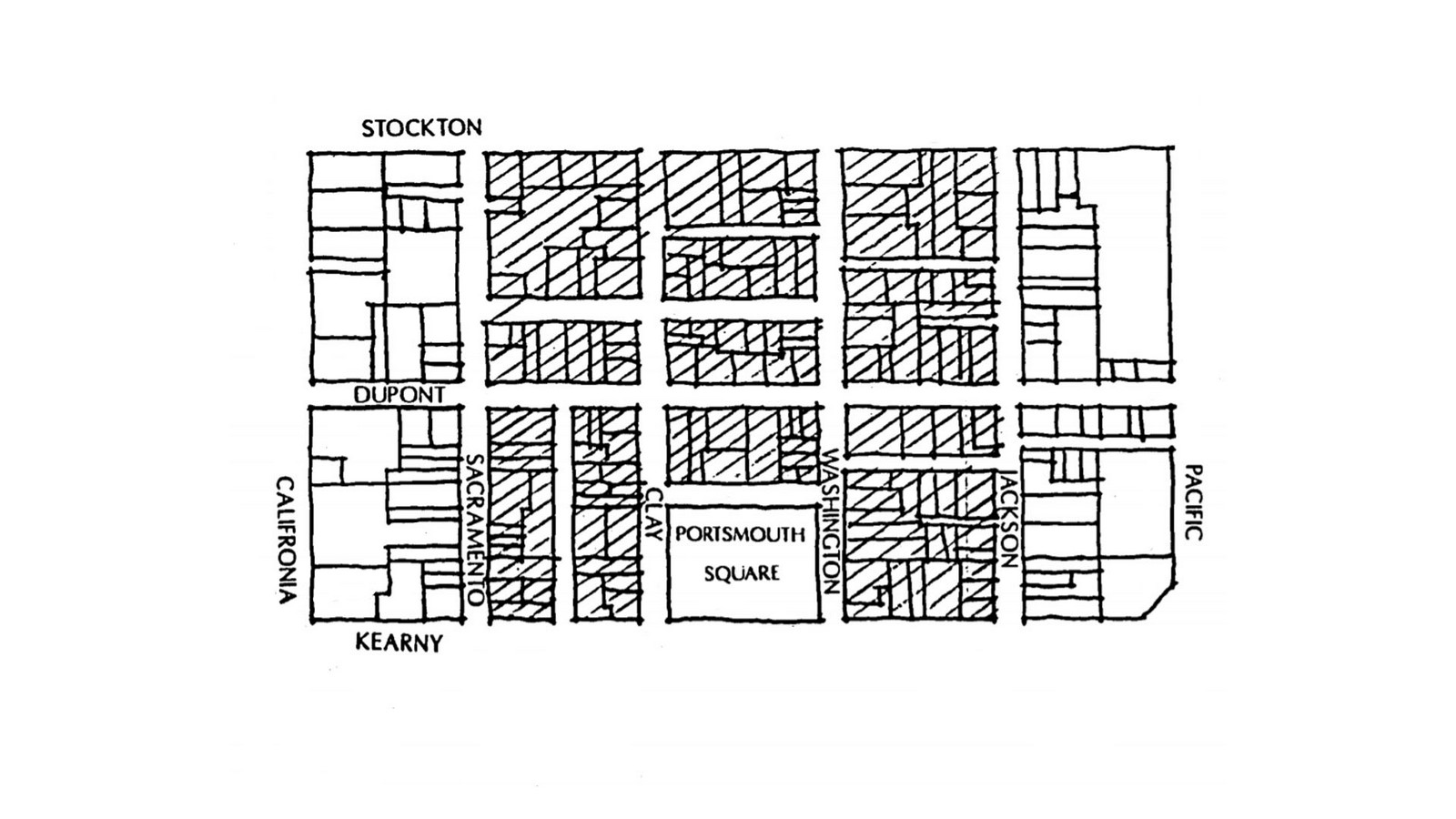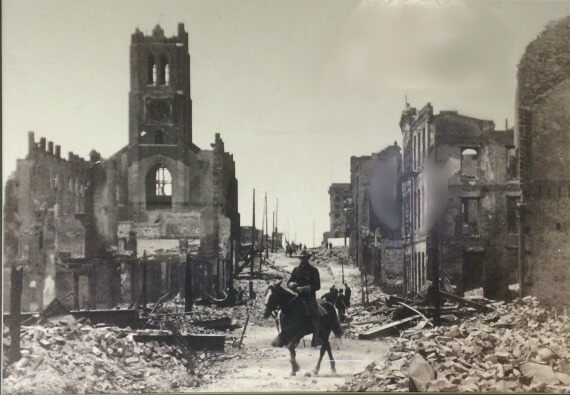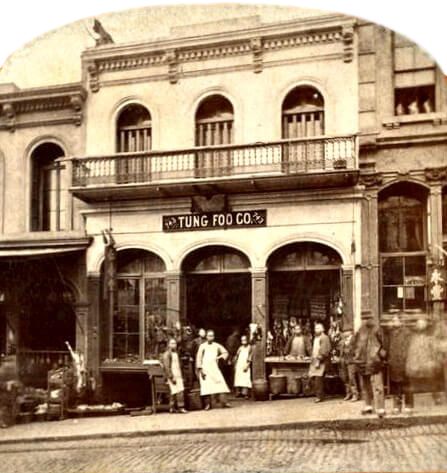In 1906, a natural disaster completely changed the lives of many living in the city of San Francisco. Although, it was a disaster that caused many to lose everything, their homes and livelihoods however for one community, despite the huge number of deaths and the loss of everything they owned, there was a silver lining. It was as if Heaven had given them a chance to keep the land they were struggling to retain, that was the Chinese community.
The History behind the Chinese Exclusion Act
In the mid 1840s, due to a series of famines, peasant uprisings, rebellions after the defeat of the British in the Opium War, many Chinese, especially from the southern part of China, came to San Francisco in search for work. Most immigrants found work in railroad construction, mining and agriculture. However, due to the desperation of these new immigrants for money, they were willing to accept lower wages and work for longer hours and with fewer days off. However, as the US economy weakened, they soon drew the ire of first and second generation Americans. In addition to that, the prostitution, opium dens, gambling and the criminal gangs, known as the “Tong” who operated the area that was known as Chinatown, further gave the image that the Chinese community were dirty, immoral and dangerous.

This discrimination was reflected in the pattern and layout of Chinatown in the 19th century which stopped the expansion of the Chinese community to other areas. Although some Chinese businesses had initially settled in other residential areas, however as Sinophobia gradually increased in the 1850s and 1860s and slowly, the Chinese associations and businesses who were forced out of the other residential areas moved into Chinatown, while their white counterparts moved out until only the Chinese occupied the blocks bound by Kearny, California, Pacific and the Stockton streets. This was because it was the only geographical region deeded by the city which allowed the Chinese to inherit and inhabit the dwellings.

In the 1870s, economic depression further intensified prejudice against the Chinese. White mine workers who were fighting to get more rights in the workplace spurred by labor organizers like Denis Kearny fought to keep chinese laborers out of California as they blamed them for breaking their strikes. However, the Chinese Community was protected by the Burlingame-Seward Treaty for some time, which prevented them from eliminating Chinese immigration, allowed them to travel without restriction and access to schooling and education in the US. But things changed in 1880, when the Angell Treaty was signed. This limited immigration from China. Now that diplomatic restrictions were no longer in place, Congress passed the Chinese Exclusion Act in 1882. This prohibited Chinese immigration for 10 years and declared that the Chinese were ineligible for neutralization.
The 1906 Earthquake and fire
Just before the San Francisco Earthquake and fire, there were plans to relocate the Chinese community out of their home to an area further from the center of the city due to plans to build a large financial hub in the area. Hence, the land which Chinatown was on, became extremely valuable. However on April 18 1906, the earthquake and the fire completed leveled Chinatown. What the city had wanted to abolish for several decades had been destroyed in a matter of minutes. Unfortunately for the city’s fathers, birth and immigration records were also destroyed during the disaster. Many San Francisco Chinese used this loophole to claim American citizenship and send for their families to join them.

Rebuilding Chinatown after the Earthquake and Fire
Now that San Francisco Chinese were able to claim American citizenship, the next problem was to rebuild Chinatown before the community were forced to relocate out of the area that was previously their home. A wealthy businessman named Look Tin Eli and other prominent members of the chinese community developed a plan to rebuild Chinatown so that they could not be forced out so easily. They obtained a loan from Hong Kong and designed the new Chinatown to be more “Oriental” to the Western eye, instead of the Edwardian style building from before.

To do this, the Chinese merchants hired white architects, who came up with a unique architectural vernacular. Architect T. Patterson Ross and engineer A.W. Bergen were among the two who were employed to combine Eastern elements to western buildings.
For example, for the Sing Chong building, which formed one of the gateways to Chinatown, were decorated with curled up eaves and terracotta motifs to contrast the brick buildings. Pagoda like towers were also placed on top of each corner of the building. Although they contained elements of Chinese architecture, however one would struggle to find anything the same in actual ancient Chinese architecture.

But nevertheless, it achieved what it’s planners wanted. The colorful and exotic architecture rebranded the community. Instead of a drab slum that represented criminal activity, it’s bright red, yellow, green buildings made it a family-friendly town that attracted visitors, drawn in by their curiosity of this new, wonderland of a village. And the success of this rebranding, caused Chinatowns that sprung up in other parts of the world to follow suit.
The Chinatown of today
Despite the glamorous oriental facade, Chinatown still has it’s issues. For example, criminal gangs still remind people of their presence in a rare fight in Chinatown, or Sinophobia which can still be felt by the Chinese community in times of difficulty. But with the collective efforts of community, who strive to improve the lives of the community members, it has now a fairly self sufficient neighborhood with it’s own schools, residences and businesses. And most of all, it represents the adaptability and creativity of a community who had managed to survive in times of adversity.

References:
Pbs.org. (2019). Chinatown | The Story of Chinatown. [online] Available at: https://www.pbs.org/kqed/chinatown/resourceguide/story.html.
Choy, P.P. and America, C. of C. (2012). San Francisco Chinatown: A Guide to Its History and Architecture : An Excerpt. [online] HuffPost. Available at: https://www.huffpost.com/entry/san-francisco-chinatown-_b_1728529
Gary Kamiya & Paul Madonna. (2020). Spirits of the City: Chinatown: San Francisco’s Potemkin Village. [online] Available at: https://nobhillgazette.com/spirits-of-the-city-chinatown-san-franciscos-potemkin-village/
History.com. (2019). Chinese Exclusion Act. [online] Available at: https://www.history.com/topics/immigration/chinese-exclusion-act-1882
History.com.(2018). History of San Francisco’s Chinatown. [online] Available at: https://www.history.com/topics/immigration/san-francisco-chinatown
Northern California Coalition on Immigrant Rights(1997). Chinese Immigration Historical Essay. [online]. Available at: https://www.foundsf.org/index.php?title=Chinese_Immigration

You have to see this from a holistic point of view. This did not just happen in isolation. An overview article published on September 2018 by D Vitiello of Univ of Pennsylvania on researchgate net website illustrated this situation well.
Planners have targeted Chinatowns in US since the City Beautiful era in the 1890s. Not too many years after there were Asian neighborhoods in certain cities. There were 2 other demolition waves after the City Beautiful era. The Urban Renewal area that started in 1940s and the postindustrial downtown revitalization era that started in the 1980s.
Page 7 of Vitiello’s article mentioned regional plans, boulevard and road extension projects, civic centers and building plans targeted Chinatowns. Resulting in Chinatowns across the country getting increasingly smaller. Some Chinatown essentially disappeared.
Vitiello also includes a couple of Canadian Chinatowns in his article.
Chinatown in Washington DC suffered through most of these waves and had parts of it torn down to build federal buildings, which shows some of the backers of these movements. The remaining parts of DC Chinatown that exist today are small and are now padded with national or comparable chain restaurants and coffee shops like La Colombe, American seafood restaurant chain.
While the Seattle Kingdome-related demolition can be seen as largely marking the late part of the third wave, there are still many attempts to build low income housing, prison, homeless shelters in ethnic neighborhoods.
Historians who pored through old publications tended to find ethnic neighborhoods often got labeled as filthy slums before they get torn down. So having homeless shelters built near your ethnic neighborhood could effectively increase the chance of having your area labeled as filthy which may in turn increase your area of getting demolished as the eventual step.
Manilatown once thrived in San Francisco from the 1920s to late 1970s.
Some recent examples of events and attempts that may lead to a series of other events that may eventually lead to the demolition of ethnic neighborhoods
September 2020. NY Chinatown residents won lawsuit to keep jail out of community.
September 10th, 2021. NBC bay area website reported that the plan to turn SF Japantown Kimpton Buchanan Hotel into homeless housing is facing resistance.
December 16th, 2020. NBC news website. How the Pandemic Threatens to Destroy America’s Three Remaining Japantowns.
July 2021. SF Sunset residents push back against neighborhood affordable housing plan.
Racial composition of South Sunset District is 43% Asians, 5% Native Hawaiian or Pacific Islander. Asian Americans and Pac Islanders amount to 48% of residents.
32% White, 8% Hispanic, 6% Multiracial, 4% Black.
Political leaders such as congress members are very effective at inciting hate against specific ethnic group with inflammatory statements. Most advanced economies’ opinions of China is at record low according to recent Pew Research poll.
October 2021. Newsweek. NC Republican Congressman Madison Cawthorn vows to seize all Chinese Assets in US.
October 2020 report from Stop AAPI Hate listed examples of inflammatory and racist comments from numerous senators such as Tom Cotton, Bill Hagerty, Cory Gardner, Jason Lewis, Lauren Witzke, Kelly Loeffler, Joni Ernst.
June 30th, 2021. Pew Research. Unfavorable Views of China Remain Near Historic Highs in Most Economies.
Stop AAPI Hate’s June 2021 report on US Anti-Asian Hate. 4533 reports of anti-Asian hate incidents in the first half of 2021, of which 16.6% (752 cases of the 4533 total incidents) involve physical assaults.
Cal State University, San Bernardino also published its Anti-Asian Prejudice and Hate Crime Report. Page 4 showed the hate crime statistics from Toronto, Vancouver, Montreal, Ottawa.
Despite the dizzying headlines of how China is gobbling up world wealth, according to Google, in 2018 the G7 countries account for 10% of world population and owns 60% of world wealth. G7 median incomes are much higher than China’s.
Insider trading is tolerated and rampant. You can read wallstreetparade website on Federal Reserve presidents of Boston and Dallas, Kapan and Rosengren. Other similar publications have similar articles on Jerome Powell and Blackrock. Insider trading by Nancy Pelosi’s husband, Paul Pelosi.
Whistleblowers on mass misbehavior or other crimes like Natalie Edwards, Daniel Hale are sent to prison. Trillion dollar tax and financial scandals involving Barclays, UBS, Credit Suisse, Deutsche Bank, HSBC, JP Morgan in LuxLeak, Swiss Leak, FinCen, Pandora and other “P” Papers. On top of massive frauds by Madoff, Jeffrey Skillings. But according to the media, only China is the world’s top problem today.
Asia’s rich agricultural and mineral resources are highly coveted. As such, many countries in the region get targeted for corporate and G7 exploitation. Some articles are on The Guardian website. 1998 October Ocensa Consortium Colombian pipeline
Once your resources are coveted, your probability of getting labeled as axis of evil spikes up.
Other similar articles can be found in
archive globalpolicy org 2001 0621exxon
foei org eight royal dutch shell scandals
grain org
VICE and CNBC banana republic documentaries
LikeLike
To clarify, people of color with African, Latin American ancestry suffer the same fate.
Similar to the housing redlining practice from 1930s that lasted until 1968.
All experience increased likelihood of displacement.
Like Asia, Africa, Latin America all suffer from resource exploitation.
We live in and inherit a lot of color-coded legacy from previous generations.
LikeLike
Good read!! Thank you!!
LikeLiked by 1 person